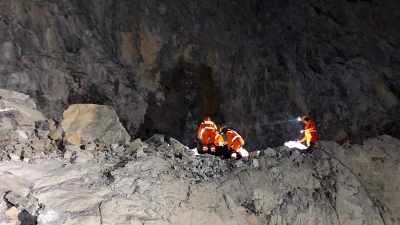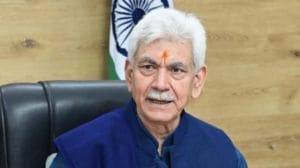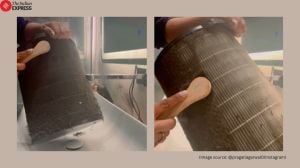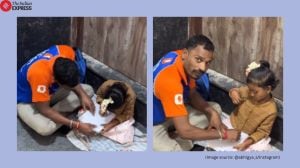Poll battlelines drawn: BRS mascot KCR and its other key faces in Telangana
CM K Chandrashekar Rao is aiming for a hat-trick in November 30 polls, even as BRS is perceived to be grappling with 'anti-incumbency', resurgent Congress and combative BJP
 Chief Minister Kalvakuntla Chandrashekar Rao, 69, popularly known as KCR, is aiming for a hat-trick in the upcoming polls. (File)
Chief Minister Kalvakuntla Chandrashekar Rao, 69, popularly known as KCR, is aiming for a hat-trick in the upcoming polls. (File) With Telangana set for the Assembly polls on November 30, the ruling Bharat Rashtra Samithi (BRS), led by K Chandrashekar Rao, is going all out in its bid to return to power for the third consecutive time since 2014, when the state was carved out of Andhra Pradesh. In this election, the BRS, formerly the Telangana Rashtra Samithi (TRS), is perceived to be grappling with “anti-incumbency”, a resurgent Congress and a combative BJP. Here are some of its leaders the TRS is banking on to overcome these challenges:
K Chandrashekar Rao
Chief Minister Kalvakuntla Chandrashekar Rao, 69, popularly known as KCR, is aiming for a hat-trick in the upcoming polls. Last Dussehra, he renamed the TRS – the party he founded on April 27, 2001 – as the BRS in an attempt to go national. Later, he scaled down his ambition, confining it to neighbouring Maharashtra. A resurgent Congress, energised by its triumph in the May Karnataka polls, and an aggressive BJP have tied him down to Telangana.
KCR’s another worry is his daughter and MLC K Kavitha’s name being embroiled in the Delhi excise policy “scam” case. Sources in BRS say that KCR views the Congress as a more serious threat than the BJP.
To gain a head start in the poll race, KCR had declared his party’s candidates for 115 of the state’s total 119 Assembly constituencies about one-and-a-half months ago. He also announced the continuation of several welfare schemes, launching the “CM’s breakfast scheme” to provide nutritious breakfast to government school kids.
When he founded the TRS, KCR had said that it was with the objective of securing statehood for Telangana, which became a separate state in June 2014. Subsequently, he started focusing on developing the state on various agricultural and economic parameters.
An eight-time MLA, KCR has won from the Siddipet seat six times from 1985 to 2004, and from Gajwel in 2014 and 2018. He is also set to contest from the Kamareddy Assembly constituency in this election. He also been a six-time MP too.
KCR had started his political innings in the Congress party’s youth wing Youth Congress, but went on to become a senior leader in the Telugu Desam Party (TDP). He was a minister in TDP founder N T Rama Rao’s Cabinet in undivided Andhra Pradesh. He was inducted as the Transport Minister in the N Chandrababu Naidu Cabinet in 1996. He served as the Deputy Speaker in the AP Assembly too.
In the 2004 Lok Sabha polls, KCR was elected from the Karimnagar constituency, even as the TRS extended support to the Congress-led UPA for formation of its government. Although he was inducted into the Manmohan Singh Cabinet, KCR was without a portfolio for several days but was eventually given the Labour and Employment portfolio. He had a fractious relationship with the Congress which had then ignored his demand for a separate state. After two years, a miffed KCR resigned from the UPA ministry and withdrew his party’s support to it.
He returned to Hyderabad and immersed himself in the separate state movement. The TRS’s debacle in the 2009 polls virtually derailed his plans and the Telangana movement. On September 2, 2009, just three months after leading the Congress to power for a second time, Andhra Pradesh CM Y S Rajashekara Reddy died in a helicopter crash.
KCR then renewed the Telangana movement, organising huge rallies, protest marches, bandhs and road blocks. Protesters laid siege to Hyderabad. He became the face of Telangana pride as he kept invoking regionalism in his speeches. Extending support to him, government employees would go on strike for weeks, enduring pay cuts, which paralysed the administration.
KCR launched a fast unto death on November 29, 2009, demanding that the UPA government introduce the Telangana Bill in Parliament. His hunger strike caused an upheaval in Telangana by triggering violent protests. After eleven days and with KCR’s health deteriorating, the Centre announced that the process of creation of Telangana would be set in motion. From a low point in May 2009, when his party won just 10 Assembly seats and 2 Lok Sabha seats, KCR thus made a comeback with a bang. He had achieved what he had set out to do in April 2001, when he took an oath to fulfil the dream of statehood for Telangana.
Born in Chintamadaka village in Medak district in Telangana, KCR secured a Master’s degree in the Telugu literature from the Osmania University.
In the 2014 elections, KCR led the TRS to victory, winning 63 of 119 Assembly seats and 11 of 17 Lok Sabha seats. “He came up with schemes like rythu bandhu, old age pensions, Dalit bandhu, free power to farmers, sheep distribution, and many others which have changed the lives of people of the state. Under him, Telangana has also become the leading producer of paddy,’’ says SC (Scheduled Castes) and Minority Welfare Minister Koppula Eshwar.
“Since formation of Telangana state, there is no other leader of any party, who can match KCR’s popularity. His image as the man who changed the fortunes of Telangana will remain forever. He is the most powerful leader in the state at present,” Minister Talasani Srinivas Yadav says.
KCR’s name is now associated with huge projects like the Kaleswaram irrigation project, mission Kakatiya meant for repairing ponds, lakes and tanks, and mission Bhagiratha for providing drinking water to every household in the state. He has also headed the renovation and development project worth over Rs 1,000 crore for the Yadadri temple.
A staunch believer in vaastu, the BRS supremo refused to work from the secretariat building saying it had “vaastu loopholes”, and worked from his home-cum-office Pragati Bhavan. The old secretariat has since been pulled down and over Rs 600 crore has been spent to build the the new vaastu-compliant secretariat.
Hoping to maintain cordial relations with the BJP-ruled Centre, KCR remained neutral or supported the Narendra Modi government through demonetisation, GST, and other contentious issues until May 2020. He turned against the Modi government gradually, accusing it of indulging in “discrimination” against the state, and failing to fulfil promises. The Centre’s refusal to purchase paddy from Telangana was the final straw and KCR went after PM Modi, calling him a “fascist” and “dictator”. He has since stopped meeting Modi, even defying protocol by not receiving the PM when he arrives in the state.
K T Rama Rao
K T Rama Rao, 47, popularly known as KTR, is KCR’s son and Telangana’s IT, Industries, and Municipal Administration Minister. While he is popular among youth, KTR has maintained a low profile in state politics with his father taking the centrestage.
Last year, in an indication of KTR’s rising status, KCR sought to put him on the national stage when on June 27 he sent him to New Delhi to accompany Yashwant Sinha to file his nomination papers as the joint nominee of the Opposition parties in the Presidential poll. It was a significant moment for KTR as he rubbed shoulders with top Opposition leaders like Rahul Gandhi, Sharad Pawar, Farooq Abdullah, Akhilesh Yadav, and others. That was the first time that KTR participated in a major event involving regional parties in the national capital.
KTR, who is very active on social media, has been equally scathing like KCR in his attacks on the BJP and PM Modi. While KCR takes pot shots at the PM during public speeches or press briefings, KTR uses social media to take aim at the BJP leaders including the PM over various issues. “His popularity, especially among youths and people in general, is his plus point,’’ Minister G Kamalakar says.
An MSc in bio-technology and an MBA, KTR is credited with transforming Hyderabad into an IT powerhouse rivalling Bengaluru. This is his second stint as the IT Minister. While the IT sector expanded enormously in the last eight years in Hyderabad, KTR was instrumental in launching the T-hub (technology hub), a business incubator, in the city in 2015. His IT policies also encouraged IT companies to set up branches in two-tier cities like Warangal.
KTR also burnished his credentials as the Industries Minister as the state topped in ease-of-doing business, especially over the introduction of the Telangana State-Industrial Project Approval and Self Certification System (TS-iPASS) which gives easy clearance to industrial projects. The BRS camp credited KTR and his team for creating the “business-friendly environment” which brought in Kerala’s Kitex company to Warangal with an investment of nearly Rs 1,000 crore.
KTR made his debut in electoral politics in 2009 when he contested and won from the Sircilla Assembly constituency. He has since won four times from there, including a bypoll. He is all set to contest in this election too.
Talasani Srinivas Yadav
BRS leader and Minister for Animal Husbandry, Fisheries, Dairy Development Corporation and Cinematography Talasani Srinivas Yadav is considered as one of the most popular ministers in Telangana. He is in-charge of the massive sheep distribution scheme in the state, who oversaw the distribution of over 1 crore sheep to the Golla and Kuruma communities.
A five-time MLA, Talasani is a former TDP leader who was once close to its chief Chandrababu Naidu. He won on the TDP ticket from Secunderabad in 1994, 1999, and 2004. He won again from Sanathnagar on the TDP ticket in 2014, but later joined the BRS. He contested in December 2018 again on the BRS ticket from Sanathnagar and won. He was then appointed as a minister in February 2019.
Sanathnagar is in the heart of Hyderabad and Talasani is likely to play a crucial role in rallying support for the BRS in the city for its candidates in the face of an aggressive BJP and Congress. A popular leader among the BC (Backward Classes) communities, which make up about 52 per cent population in the state, Talasani organises the yearly BC Garjana public meeting, which is popular and attended by thousands of people.
“BCs are more than 50 per cent in Telangana and their support is very crucial for any party. Talasani Srinivas Yadav is quite popular among the communities and is touring the state to ensure their support. He is a very valuable leader for the BRS and the CM entrusts a lot of responsibility to him,’’ a BRS leader said.






- 01
- 02
- 03
- 04
- 05

























